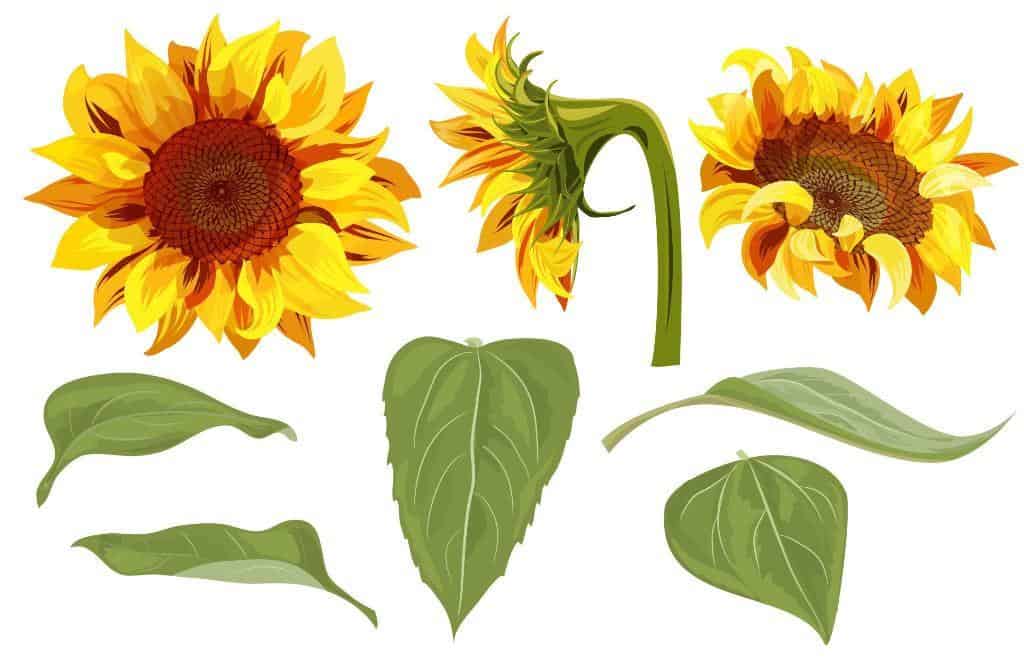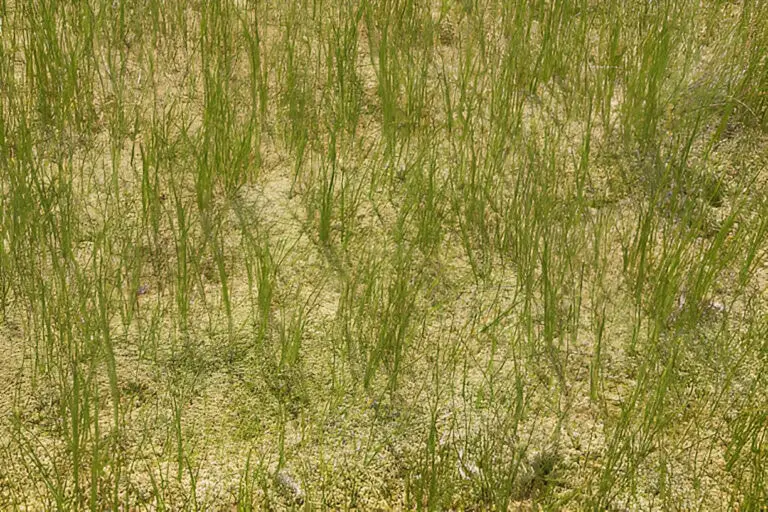Why Are Sunflower Leaves and Heads Drooping? (Turning Yellow Color)

As the sun slowly rises in the sky, the flower heads of the sunflowers begin to pivot, and the sunflowers follow the sun’s movement. It is an amazing sight to behold, as though they are greeting the sun as it comes up.
Throughout the day, they continue to track the sun as it moves across the sky, until it finally sets in the evening. For those who enjoy watching nature, it is a truly mesmerizing experience.
However, sometimes your sunflowers stop to track the sun’s movement. Your sunflower leaves and heads are drooping, starting to bow over, and seem to be staring at the ground. Whether this occurs when they’re young seedlings or in full flower, it can be disheartening to see your plants in distress.
When flowers unexpectedly wilt and drop their petals, it’s natural to feel alarmed. So why are sunflower leaves and heads drooping? This can be caused by a number of things, including lack of sunlight, overwatering, nutrient deficiencies, or pests.
Whatever the cause, it’s important to take action quickly so that your flowers can get back to looking their best.
Is It Natural for Sunflowers To Droop?
Just as leaves on trees begin to turn yellow and eventually droop as fall approaches, so too do sunflowers. It’s a natural life cycle for the plant as it becomes heavy with seeds that will soon be ready to harvest.
Don’t worry if your sunflowers start to droop in the late summer or early fall. It’s perfectly natural and part of the sunflower life cycle stages. The plant is simply getting ready to produce sunflower seeds that can be harvested and used for planting next season.
The plant is reaching the end of its life cycle: Sunflowers typically only bloom for a few weeks before they start to die off. As the plant starts to die, its leaves and flowers will droop.
Why Do Sunflowers Leaves and Heads Drooping
Both young and old sunflower plants can develop drooping at a certain age in their lifecycle. The cause of the droop can vary depending on the stage of growth the plant is in. Depending on what stage of growth they are in, you can decide what to do about drooping sunflowers.
Droopping in Young Sunflowers Plants
If you have a young sunflower plant and its leaves and head are drooping, there are a few potential causes. One possibility is transplant shock, which occurs when a plant is stressed from being transplanted.
This can happen if sunflower seedlings are moved too soon after germination or if the roots are disturbed during transplanting. Poor care and unsuitable growing conditions can seriously harm sunflower seedlings. Transplant shock is more likely to occur in hot weather.
So you better put your seedling trays and pots in the sun for a few hours a day in a protected spot with firm ground.
Another possibility is a fungal disease called Fusarium wilt, which can affect sunflowers of all ages. The fungus enters the plant through the roots and causes the leaves to turn yellow and then brown before dropping off.
The plant may also produce fewer flowers or no flowers at all. If you suspect your sunflower has either of these problems, you should take it to a nursery or gardening center for diagnosis and treatment recommendations.
Droopping in Mature Sunflowers Plants
If your mature sunflower leaves are drooping and the color is turning yellow, the first thing you should check is the soil moisture.
Sunflowers need about 1 to 1.5 inches of water per week. If the soil is dry, give your sunflower a good soak. Be sure not to overwater, though, as this can also cause problems.
If the soil is too dry, the sunflower will start to wilt. By wilting, they are trying to conserve water. When the sun shines on the leaves, they lose water quickly through evaporation. The leaves and heads droop in order to reduce this evaporation
Another reason could be that the plant is getting too much sun. If the leaves are scorched or dried out, they will droop. This further protects them from the harsh rays of the sun.
Finally, if your sunflowers’ heads and leaves are drooping, it may be a sign that they’re not getting enough nutrients. Sunflowers need a lot of nutrients to grow, so if you’re not fertilizing your plants regularly, they may start to show signs of nutrient deficiency.
If you see your sunflowers drooping, try giving them a little extra water and fertilizer.
What Do Sunflower Leaves Look Like?

When it comes to the leaves of a sunflower, there are a few things that you should know. For one thing, they are large and green.
The leaves of sunflowers are typically triangular or heart-shaped. The leaves are divided into discrete portions by a little spine. Usually, the leaves of sunflowers are dark green, but depending on the type of sunflower you’re growing, the leaves may be other colors.
But what else do sunflower leaves look like?
Sunflower leaves are typically about 6 inches wide and 12 inches long. They have a rough texture and are covered in small hairs. The edges of the leaves are serrated, or jagged.
Sunflower leaves grow directly from the stem of the plant. They are arranged alternately along the stem, meaning that they don’t all grow from the same spot. Each leaf has a stalk, or petiole, that attaches it to the stem.
The leaves of a sunflower play an important role in the plant’s life cycle. They take in sunlight and transform it into the plant’s food.
How Can You Spot a Dying Sunflower?
When a sunflower is dying, there are several telltale signs. The leaves may begin to turn yellow or brown and curl up at the edges.
The stem may become weak and thin, and the flower head may droop or fall off entirely. In some cases, the entire plant may turn brown and wither away. If you see any of these signs, it’s likely that your sunflower is nearing the end of its life.
Another telltale sign is when the sunflower starts to wilt. If you see these signs, it’s best to give your sunflower some extra attention and TLC.
Why Are Sunflowers Leaves Turn Yelow or Brown Color?
Sunflower leaves are turning yellow, and it’s worrying gardeners everywhere. Is it a sign of something serious, or is it just a natural part of the plant’s life cycle?
Experts say that there could be a few reasons why sunflower leaves are turning yellow. It could be due to a nutrient deficiency, or it could be because the plant is under stress from too much heat or not enough water.
Sometimes, yellowing leaves are simply a sign that the plant is mature and starting to senesce, or die back.
But the most common reason why sunflowers turn color is disease. If your plant is infected with a virus or fungus, the leaves will begin to turn yellow and may eventually fall off.
| Pests can also cause sunflower leaves to turn yellow. Aphids, whiteflies, and spider mites are all common pests that can attack sunflowers and cause the leaves to turn yellow. |
How To Prevent Sunflower Leaves From Turning Yellow or Brown Color?
1. Use Top-Notch Soil When Planting
If you want to prevent sunflower leaves from turning brown, use high-quality soil for planting. The quality of the soil will determine how well the plant grows and how healthy it is. If you use poor quality soil, the plant will be more likely to experience problems such as nutrient deficiencies and pests.
To ensure that you have the best chance of growing sunflowers that are healthy and strong, start with high-quality soil. You can find this type of soil at most garden stores or online. Be sure to read the description so that you know what nutrients are included in the mix.
When you’re ready to plant, loosen the soil around the planting hole and add some compost if needed. Then, carefully place your sunflower in the hole and backfill with soil. Water deeply immediately after planting and keep the soil moist throughout the growing season.
2. Space Plant Properly
When planting sunflowers, it is important to space them correctly. If they are too close together, the leaves will start to turn brown.
Sunflowers need at least six hours of sunlight a day, so make sure to plant them in a sunny spot. Water the sunflowers regularly and fertilize them every two weeks.
3. Fertilize Your Sunflowers
Sunflower leaves can turn brown for a number of reasons, but often it is due to a lack of fertilizer. If your sunflower leaves are starting to turn brown, you can take some preventative steps by fertilizing your plants.
Fertilizing your sunflowers will give them the nutrients they need to stay healthy and prevent their leaves from turning brown. You can use any type of fertilizer, but organic fertilizer is best. Apply the fertilizer around the base of the plant, being careful not to get any on the leaves. After fertilizer application, give the plants plenty of water.
| Try to avoid using any kind of fertilizer on your sunflowers. Fertilizers can contain chemicals that can cause the leaves to turn brown. If you must use fertilizer, make sure you choose one that is specifically designed for sunflowers. |
4. Watering but Not Over Do
If your sunflower leaves are turning brown, it is likely due to either too much or too little water. Watering your sunflower once a week should be sufficient, but be sure to check the soil before watering to see if it is dry. If the soil is dry, water the sunflower deeply so that the water reaches the roots.
Avoid watering the leaves of the sunflower, as this can cause them to turn brown.
5. Use fungicides and pesticides sparingly.
When it comes to keeping sunflower leaves healthy and free from browning, regular applications of fungicides and pesticides are a must. Here are some tips on how to prevent sunflower leaves from turning brown:
- Apply a preventive fungicide treatment to sunflower plants early in the season, before any leaf browning begins.
- Be sure to follow the directions on the fungicide label and reapply as needed throughout the season.
- If you see signs of leaf browning, treat plants with a registered pesticide immediately.
- Apply pesticides according to the label directions, and be sure to cover all affected areas of the plant.
- Monitor plants closely for additional signs of disease or pests and act quickly to treat any problems that arise.
Conclusions
There are a few reasons why sunflower leaves and heads start drooping, and most of the time, the leaves are also turning yellow. One reason could be that the plant is not getting enough water. Sunflowers need a lot of water, especially when they are blooming. Another reason could be that the plant is getting too much sun.
Sunflower leaves and heads drooping is a common problem that can be caused by several factors. Nutrient deficiencies, water stress, and fungal diseases are all possible reasons why sunflower leaves and heads might be drooping. To properly diagnose the problem, it is important to consider all of the possible causes.
By understanding the potential reasons for why sunflower leaves and heads are drooping, growers can take steps to prevent or correct the problem.






